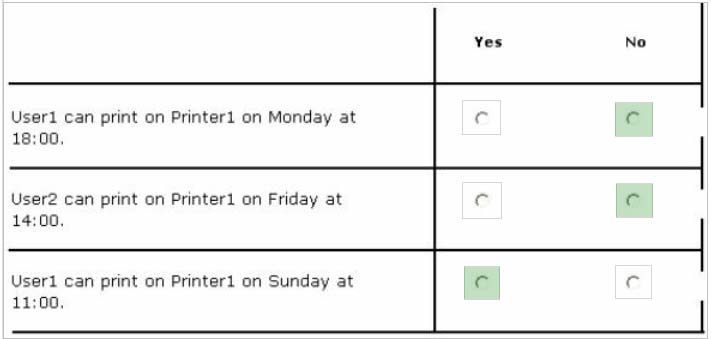Microsoft 70-410 Exam Practice Questions (P. 2)
- Full Access (550 questions)
- Six months of Premium Access
- Access to one million comments
- Seamless ChatGPT Integration
- Ability to download PDF files
- Anki Flashcard files for revision
- No Captcha & No AdSense
- Advanced Exam Configuration
Question #11
HOTSPOT -
You have a shared folder named Share1. The folder permissions of Share1 are configured as shown in the Folder Permissions exhibit. (Click the Exhibit button.)
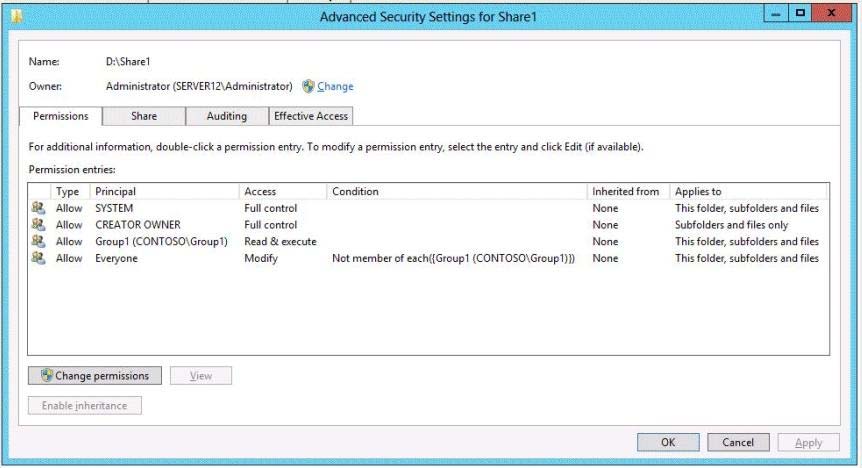
The Share permissions of Share1 are configured as shown in the Share Permissions exhibit. (Click the Exhibit button.)
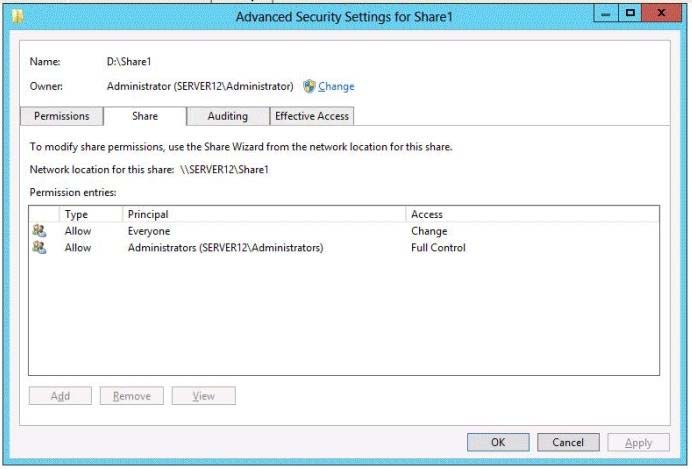
You have a group named Group1. The members of Group1 are shown in the Group1 exhibit. (Click the Exhibit button.)
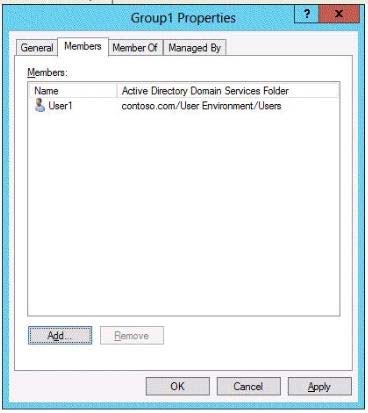
Select Yes if the statement can be shown to be true based on the available information; otherwise select No. Each correct selection is worth one point.
Hot Area:
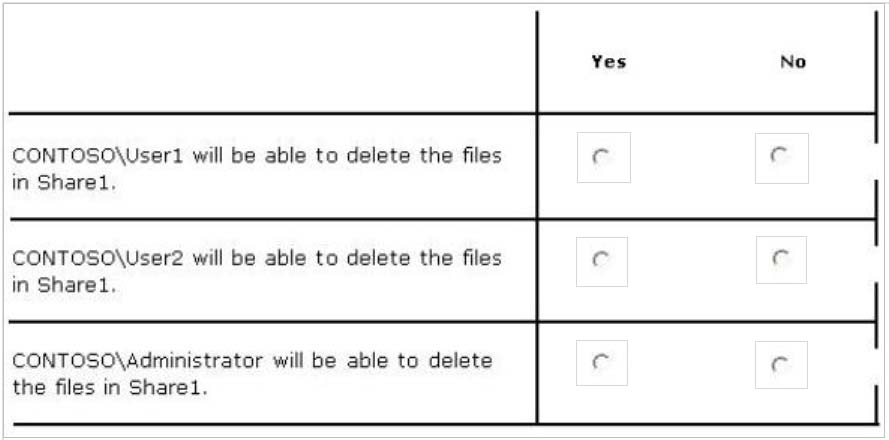
You have a shared folder named Share1. The folder permissions of Share1 are configured as shown in the Folder Permissions exhibit. (Click the Exhibit button.)

The Share permissions of Share1 are configured as shown in the Share Permissions exhibit. (Click the Exhibit button.)

You have a group named Group1. The members of Group1 are shown in the Group1 exhibit. (Click the Exhibit button.)

Select Yes if the statement can be shown to be true based on the available information; otherwise select No. Each correct selection is worth one point.
Hot Area:

Correct Answer:
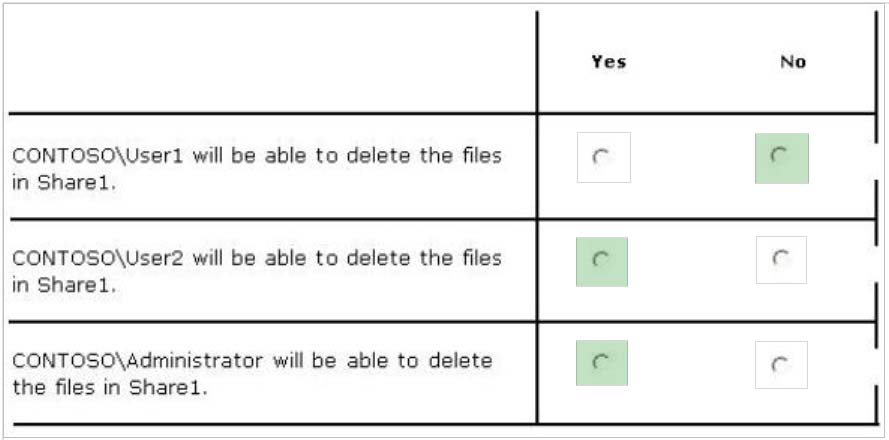
NTFS permissions control access to the files and folders stored on disk volumes formatted with the NTFS file system. Share permissions control access to folders over a network. To access a file over a network, a user must have appropriate share permissions (and appropriate NTFS permissions if the shared folder is on an
NTFS volume).Granting a user Full Control NTFS permission on a folder enables that user to take ownership of the folder unless the user is restricted in some other way.User1 was not granted Full Control permission.
The Administrators have Full Control permission. I assume that User2 is an administrator since the Group1 exhibit shows only User1 as a member.
References: http://technet.microsoft.com/en-us/library/cc754178.aspx share access, p.75-80

NTFS permissions control access to the files and folders stored on disk volumes formatted with the NTFS file system. Share permissions control access to folders over a network. To access a file over a network, a user must have appropriate share permissions (and appropriate NTFS permissions if the shared folder is on an
NTFS volume).Granting a user Full Control NTFS permission on a folder enables that user to take ownership of the folder unless the user is restricted in some other way.User1 was not granted Full Control permission.
The Administrators have Full Control permission. I assume that User2 is an administrator since the Group1 exhibit shows only User1 as a member.
References: http://technet.microsoft.com/en-us/library/cc754178.aspx share access, p.75-80
send
light_mode
delete
Question #12
Your network contains an Active Directory domain named adatum.com. The domain contains a server named Server1 that runs Windows Server 2012 R2.
On a server named Core1, you perform a Server Core Installation of Windows Server 2012 R2. You join Core1 to the adatum.com domain.
You need to ensure that you can use Event Viewer on Server1 to view the event logs on Core1.
What should you do on Core1?
On a server named Core1, you perform a Server Core Installation of Windows Server 2012 R2. You join Core1 to the adatum.com domain.
You need to ensure that you can use Event Viewer on Server1 to view the event logs on Core1.
What should you do on Core1?
- ARun the Disable NetFirewallRule cmdlet.
- BInstall Remote Server Administration Tools (RSAT).
- CInstall Windows Management Framework.
- DRun the Enable-Com + Network Access Firewall Rule.
Correct Answer:
D
Information regarding IPsec policy changes, etc. can be found in the Event Viewer. Thus you need to enable the NetFirewallRule command. This will allow you to view the event logs.
D
Information regarding IPsec policy changes, etc. can be found in the Event Viewer. Thus you need to enable the NetFirewallRule command. This will allow you to view the event logs.
send
light_mode
delete
Question #13
Your network contains two servers named Server1 and Server2 that run Windows Server 2012 R2. Server1 and Server2 are part of a workgroup.
On Server1 and Server2, you create a local user account named Admin1.You add the account to the local Administrators group. On both servers, Admin1 has the same password.
You log on to Server1 as Admin1. You open Computer Management and you.connect to Server2.
When you attempt to create a scheduled task, view the event logs, and manage the shared folders, you receive Access Denied messages.
You need to ensure that you can administer Server2 remotely from Server1 by using Computer Management.
What should you configure on Server2?
On Server1 and Server2, you create a local user account named Admin1.You add the account to the local Administrators group. On both servers, Admin1 has the same password.
You log on to Server1 as Admin1. You open Computer Management and you.connect to Server2.
When you attempt to create a scheduled task, view the event logs, and manage the shared folders, you receive Access Denied messages.
You need to ensure that you can administer Server2 remotely from Server1 by using Computer Management.
What should you configure on Server2?
- AFrom Server Manager, modify the Remote Management setting.
- BFrom Local Users and Groups, modify the membership of the Remote Management Users group.
- CFrom Windows Firewall, modify the Windows Management Instrumentation (WMI) firewall rule.
- DFrom Registry Editor, configure the LocalAccountTokenFilterPolicy registry value.
Correct Answer:
D
The LocalAccountTokenFilterPolicy setting affects how administrator credentials are applied to remotely administer the computer.
Reference: http://support.microsoft.com/kb/942817
D
The LocalAccountTokenFilterPolicy setting affects how administrator credentials are applied to remotely administer the computer.
Reference: http://support.microsoft.com/kb/942817
send
light_mode
delete
Question #14
HOTSPOT -
You have a print server named Server1 that runs Windows Server 2012 R2.
On Server1, you create and share a printer named Printer1.
The Advanced settings of Printer1 are shown in the Advanced exhibit. (Click the Exhibit button.)
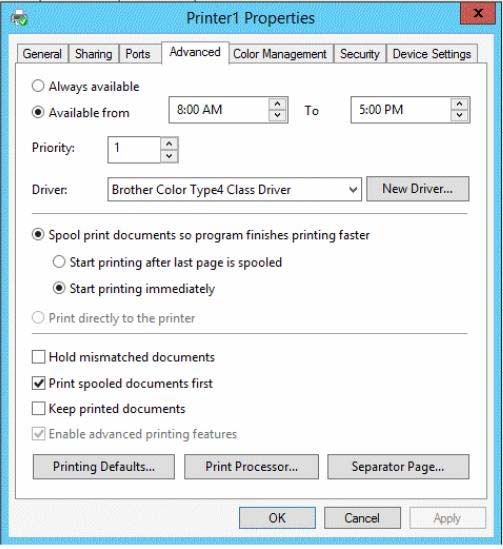
The Security settings of Printer1 are shown in the Security exhibit. (Click the Exhibit button.)
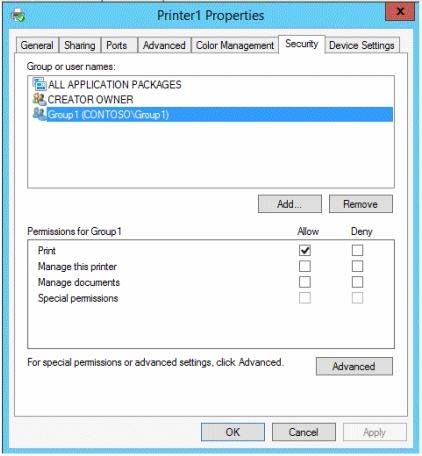
The Members settings of a group named Group1 are shown in the Group1 exhibit. (Click the Exhibit button.)
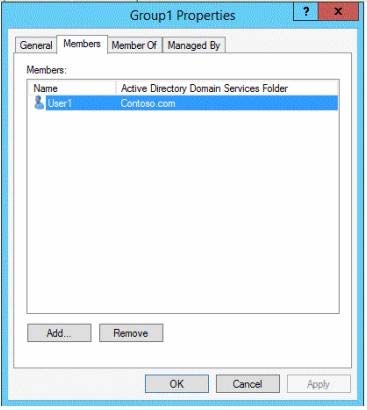
Select Yes if the statement can be shown to be true based on the available information; otherwise select No. Each correct selection is worth one point.
Hot Area:
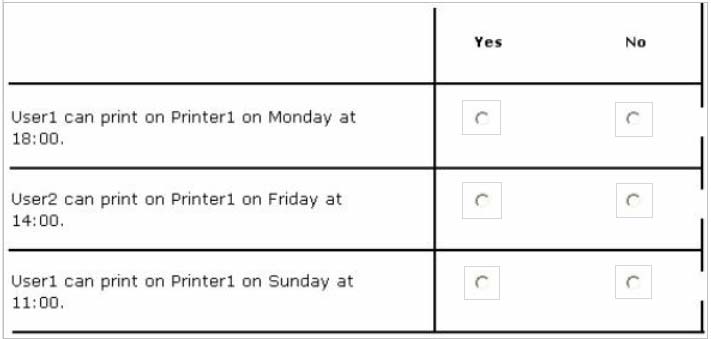
You have a print server named Server1 that runs Windows Server 2012 R2.
On Server1, you create and share a printer named Printer1.
The Advanced settings of Printer1 are shown in the Advanced exhibit. (Click the Exhibit button.)

The Security settings of Printer1 are shown in the Security exhibit. (Click the Exhibit button.)

The Members settings of a group named Group1 are shown in the Group1 exhibit. (Click the Exhibit button.)

Select Yes if the statement can be shown to be true based on the available information; otherwise select No. Each correct selection is worth one point.
Hot Area:

send
light_mode
delete
Question #15
Your network contains a server named Server1 that runs Windows Server 2012 R2. Server1 has the Hyper-V server role installed.
Server1 hosts four virtual machines named VM1, VM2, VM3, and VM4.
Server1 is configured as shown in the following table.
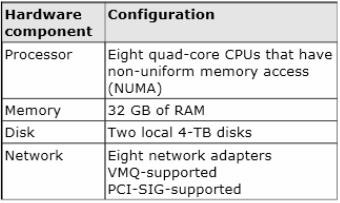
You install Windows Server 2012 R2 on VM2 by using Windows Deployment Services (WDS).
You need to ensure that the next time VM2 restarts, you can connect to the WDS server by using PXE.
Which virtual machine setting should you configure for VM2?
Server1 hosts four virtual machines named VM1, VM2, VM3, and VM4.
Server1 is configured as shown in the following table.

You install Windows Server 2012 R2 on VM2 by using Windows Deployment Services (WDS).
You need to ensure that the next time VM2 restarts, you can connect to the WDS server by using PXE.
Which virtual machine setting should you configure for VM2?
- ANUMA topology
- BResource control
- Cresource metering
- Dvirtual Machine Chimney
- EThe VLAN ID
- FProcessor Compatibility
- GThe startup order
- HAutomatic Start Action
- IIntegration Services
- JPort mirroring K. Single-root I/O virtualization
Correct Answer:
G
Configure the BIOS of the computer to enable PXE boot, and set the boot order so that it is booting from the network is first.
References: http://technet.microsoft.com/en-us/library/cc766320(v=ws.10).aspx settings, p.144
Training Guide: Installing and Configuring Windows Server 2012 R2: Chapter 7: Hyper-V Virtualization, Lesson 2: Deploying and configuring virtual machines, p.335
G
Configure the BIOS of the computer to enable PXE boot, and set the boot order so that it is booting from the network is first.
References: http://technet.microsoft.com/en-us/library/cc766320(v=ws.10).aspx settings, p.144
Training Guide: Installing and Configuring Windows Server 2012 R2: Chapter 7: Hyper-V Virtualization, Lesson 2: Deploying and configuring virtual machines, p.335
send
light_mode
delete
Question #16
Your network contains a server named Server1 that runs Windows Server 2012 R2. Server1 has the Hyper-V server role installed.
Server1 hosts four virtual machines named VM1, VM2, VM3, and VM4.
Server1 is configured as shown in the following table.
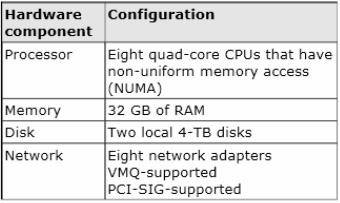
You plan to schedule a complete backup of Server1 by using Windows Server Backup.
You need to ensure that the state of VM1 is saved before the backup starts.
What should you configure?
Server1 hosts four virtual machines named VM1, VM2, VM3, and VM4.
Server1 is configured as shown in the following table.

You plan to schedule a complete backup of Server1 by using Windows Server Backup.
You need to ensure that the state of VM1 is saved before the backup starts.
What should you configure?
- ANUMA topology
- BResource control
- Cresource metering
- Dvirtual Machine Chimney
- EThe VLAN ID
- FProcessor Compatibility
- GThe startup order
- HAutomatic Start Action
- IIntegration Services
- JPort mirroring K. Single-root I/O virtualization
Correct Answer:
I
The Integration Services settings on virtual machines include services such as operating system shutdown, time synchronization, data exchange, Heartbeat, and
Backup (volume snapshot services). This snapshot will ensure that the state of VM1 is saved prior to backup.
References: http://msdn.microsoft.com/en-us/library/dd405549(v=vs.85).aspx settings, p.144
I
The Integration Services settings on virtual machines include services such as operating system shutdown, time synchronization, data exchange, Heartbeat, and
Backup (volume snapshot services). This snapshot will ensure that the state of VM1 is saved prior to backup.
References: http://msdn.microsoft.com/en-us/library/dd405549(v=vs.85).aspx settings, p.144
send
light_mode
delete
Question #17
Your network contains a server named Server1 that runs Windows Server 2012 R2. Server1 has the Hyper-V server role installed.
Server1 hosts four virtual machines named VM1, VM2, VM3, and VM4.
Server1 is configured as shown in the following table.
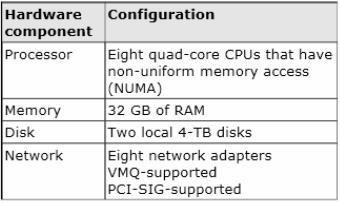
VM2 sends and receives large amounts of data over the network.
You need to ensure that the network traffic of VM2 bypasses the virtual switches of the parent partition.
What should you configure?
Server1 hosts four virtual machines named VM1, VM2, VM3, and VM4.
Server1 is configured as shown in the following table.

VM2 sends and receives large amounts of data over the network.
You need to ensure that the network traffic of VM2 bypasses the virtual switches of the parent partition.
What should you configure?
- ANUMA topology
- BResource control
- Cresource metering
- Dvirtual Machine Chimney
- EThe VLAN ID
- FProcessor Compatibility
- GThe startup order
- HAutomatic Start Action
- IIntegration Services
- JPort mirroring K. Single-root I/O virtualization
Correct Answer:
K
Single-root I/O virtualization -capable network adapters can be assigned directly to a virtual machine to maximize network throughput while minimizing network latency and the CPU overhead required for processing network traffic.
References: http://technet.microsoft.com/en-us/library/cc766320(v=ws.10).aspx http://technet.microsoft.com/en-us/library/hh831410.aspx settings, p.144
Training Guide: Installing and Configuring Windows Server 2012 R2: Chapter 7: Hyper-V Virtualization, Lesson 2: Deploying and configuring virtual machines, p.335
K
Single-root I/O virtualization -capable network adapters can be assigned directly to a virtual machine to maximize network throughput while minimizing network latency and the CPU overhead required for processing network traffic.
References: http://technet.microsoft.com/en-us/library/cc766320(v=ws.10).aspx http://technet.microsoft.com/en-us/library/hh831410.aspx settings, p.144
Training Guide: Installing and Configuring Windows Server 2012 R2: Chapter 7: Hyper-V Virtualization, Lesson 2: Deploying and configuring virtual machines, p.335
send
light_mode
delete
Question #18
Your network contains a server named Server1 that runs Windows Server 2012 R2. Server1 has the Hyper-V server role installed.
Server1 hosts four virtual machines named VM1, VM2, VM3, and VM4.
Server1 is configured as shown in the following table.
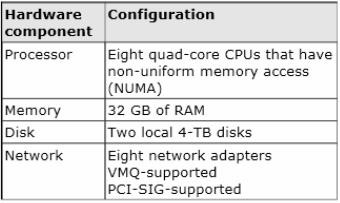
You need to ensure that VM1 can use more CPU time than the other virtual machines when the CPUs on Server1 are under a heavy load.
What should you configure?
Server1 hosts four virtual machines named VM1, VM2, VM3, and VM4.
Server1 is configured as shown in the following table.

You need to ensure that VM1 can use more CPU time than the other virtual machines when the CPUs on Server1 are under a heavy load.
What should you configure?
- ANUMA topology
- BResource control
- Cresource metering
- Dvirtual Machine Chimney
- EThe VLAN ID
- FProcessor Compatibility
- GThe startup order
- HAutomatic Start Action
- IIntegration Services
- JPort mirroring K. Single-root I/O virtualization
Correct Answer:
B
Resource controls provide you with several ways to control the way that Hyper-V allocates resources to virtual machine. Resource control in used in the event where you need to adjust the computing resources of a virtual machine, you can reconfigure the resources to meet the changing needs. You can also specify resource controls to automate how resources are allocated to virtual machines.
References:
http://technet.microsoft.com/en-us/library/cc766320(v=ws.10).aspx http://technet.microsoft.com/en-us/library/hh831410.aspx http://technet.microsoft.com/en-us/library/cc742470.aspx settings, p.144
Training Guide: Installing and Configuring Windows Server 2012 R2: Chapter 7: Hyper-V Virtualization, Lesson 2: Deploying and configuring virtual machines, p.335
B
Resource controls provide you with several ways to control the way that Hyper-V allocates resources to virtual machine. Resource control in used in the event where you need to adjust the computing resources of a virtual machine, you can reconfigure the resources to meet the changing needs. You can also specify resource controls to automate how resources are allocated to virtual machines.
References:
http://technet.microsoft.com/en-us/library/cc766320(v=ws.10).aspx http://technet.microsoft.com/en-us/library/hh831410.aspx http://technet.microsoft.com/en-us/library/cc742470.aspx settings, p.144
Training Guide: Installing and Configuring Windows Server 2012 R2: Chapter 7: Hyper-V Virtualization, Lesson 2: Deploying and configuring virtual machines, p.335
send
light_mode
delete
Question #19
HOTSPOT -
Your network contains an Active Directory domain named contoso.com.
Computer accounts for the marketing department are in an organizational unit (OU) named Departments\Marketing\Computers. User accounts for the marketing department are in an OU named Departments\Marketing\Users.
Marketing users can only log on to the client computers in the Departments\Marketing\Computers OU.
You need to apply an application control policy to all of the marketing users.
Which Group Policy Object (GPO) should you configure?
To answer, select the appropriate GPO in the answer area.
Hot Area:

Your network contains an Active Directory domain named contoso.com.
Computer accounts for the marketing department are in an organizational unit (OU) named Departments\Marketing\Computers. User accounts for the marketing department are in an OU named Departments\Marketing\Users.
Marketing users can only log on to the client computers in the Departments\Marketing\Computers OU.
You need to apply an application control policy to all of the marketing users.
Which Group Policy Object (GPO) should you configure?
To answer, select the appropriate GPO in the answer area.
Hot Area:

Correct Answer:
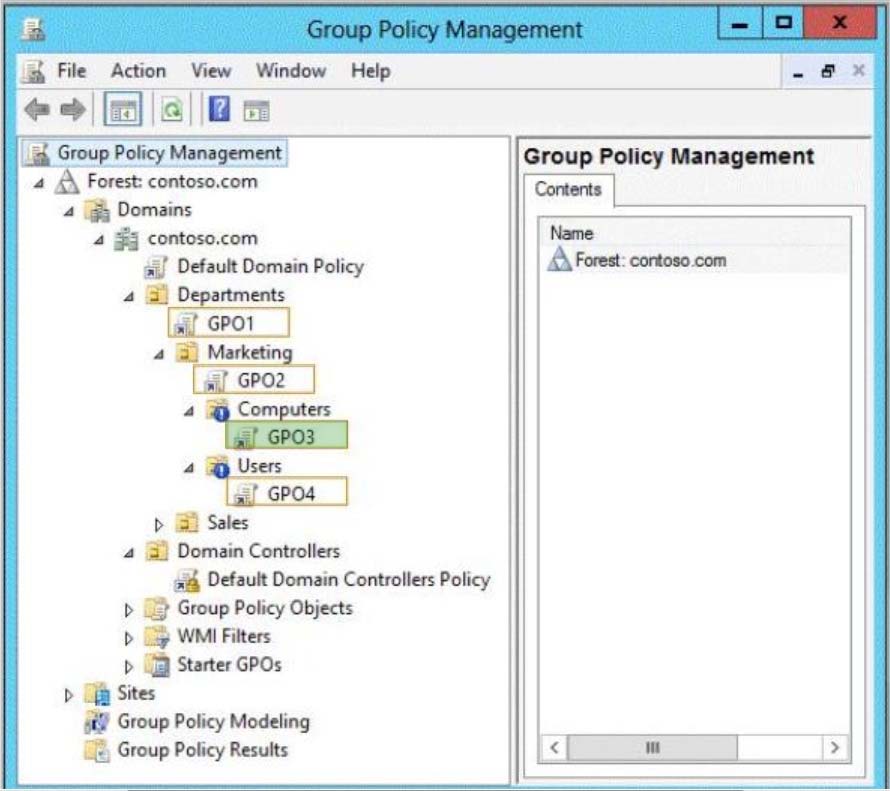
Application control policies specify which programs are allowed to run on the local computer and which are not.
References:
http://technet.microsoft.com/en-us/library/hh125923(v=ws.10).aspx http://technet.microsoft.com/en-us/library/cc781458(v=WS.10).aspx http://technet.microsoft.com/en-us/library/hh967461.aspx http://technet.microsoft.com/en-us/library/ee461050.aspx http://technet.microsoft.com/en-us/library/ee461044.aspx

Application control policies specify which programs are allowed to run on the local computer and which are not.
References:
http://technet.microsoft.com/en-us/library/hh125923(v=ws.10).aspx http://technet.microsoft.com/en-us/library/cc781458(v=WS.10).aspx http://technet.microsoft.com/en-us/library/hh967461.aspx http://technet.microsoft.com/en-us/library/ee461050.aspx http://technet.microsoft.com/en-us/library/ee461044.aspx
send
light_mode
delete
Question #20
HOTSPOT -
Your network contains an Active Directory domain named contoso.com.
The domain contains an organizational unit (OU) named OU1 as shown in the OU1 exhibit. (Click the Exhibit button.)
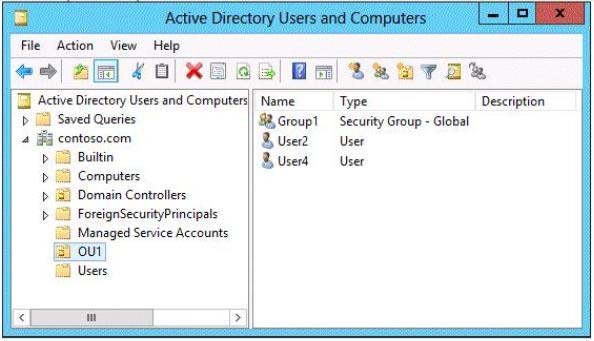
The membership of Group1 is shown in the Group1 exhibit. (Click the Exhibit button.)
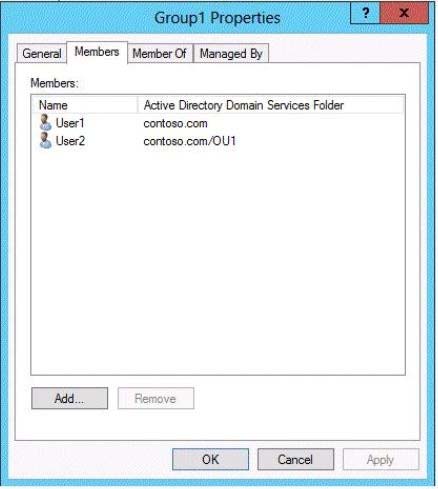
You configure GPO1 to prohibit access to Control Panel. GPO1 is linked to OU1 as shown in the GPO1 exhibit. (Click the Exhibit button.)
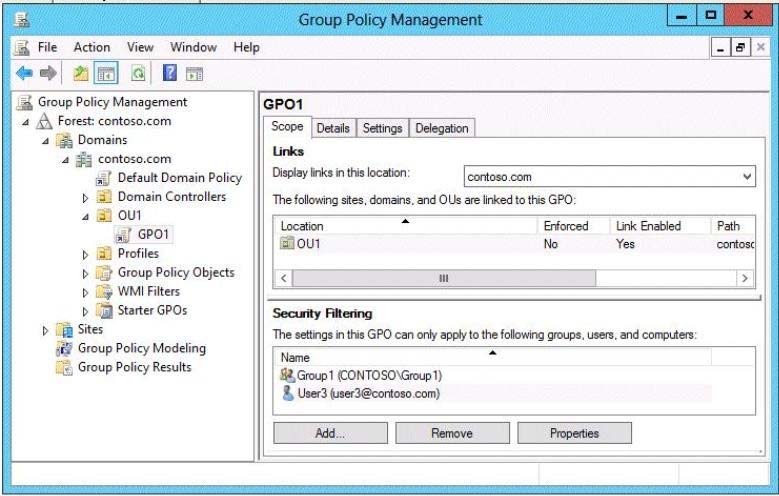
Select Yes if the statement can be shown to be true based on the available information; otherwise select No. Each correct selection is worth one point.
Hot Area:
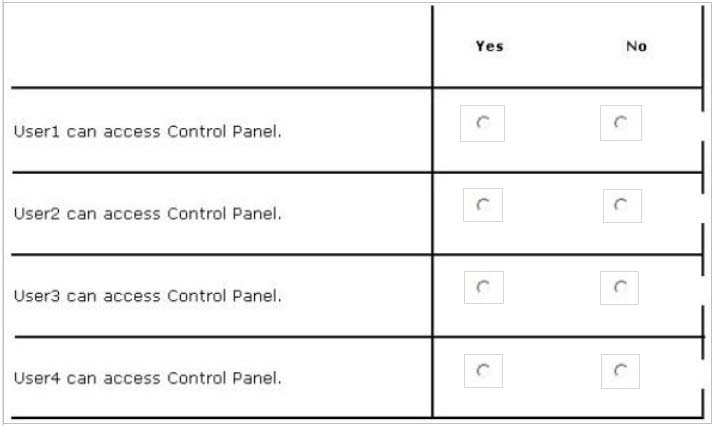
Your network contains an Active Directory domain named contoso.com.
The domain contains an organizational unit (OU) named OU1 as shown in the OU1 exhibit. (Click the Exhibit button.)

The membership of Group1 is shown in the Group1 exhibit. (Click the Exhibit button.)

You configure GPO1 to prohibit access to Control Panel. GPO1 is linked to OU1 as shown in the GPO1 exhibit. (Click the Exhibit button.)

Select Yes if the statement can be shown to be true based on the available information; otherwise select No. Each correct selection is worth one point.
Hot Area:

Correct Answer:
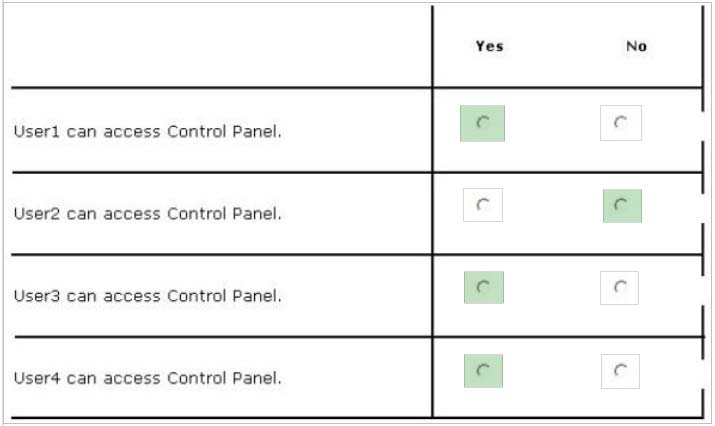
Group Policy does NOT APPLY TO SECURITY GROUPS, only users and computers in an OU. Consequently, the only users in the OU are User2 and User4.
Since the Security Filtering specifies that the policy will only apply to users/computers in the OU who are members of Group1 or User3, User4 will not have the policy applied. Since User2 is, in fact, a member of Group1, the policy will be applied to user 2. Thus, the only user who will not be able to access the control panel is User2.

Group Policy does NOT APPLY TO SECURITY GROUPS, only users and computers in an OU. Consequently, the only users in the OU are User2 and User4.
Since the Security Filtering specifies that the policy will only apply to users/computers in the OU who are members of Group1 or User3, User4 will not have the policy applied. Since User2 is, in fact, a member of Group1, the policy will be applied to user 2. Thus, the only user who will not be able to access the control panel is User2.
send
light_mode
delete
All Pages

